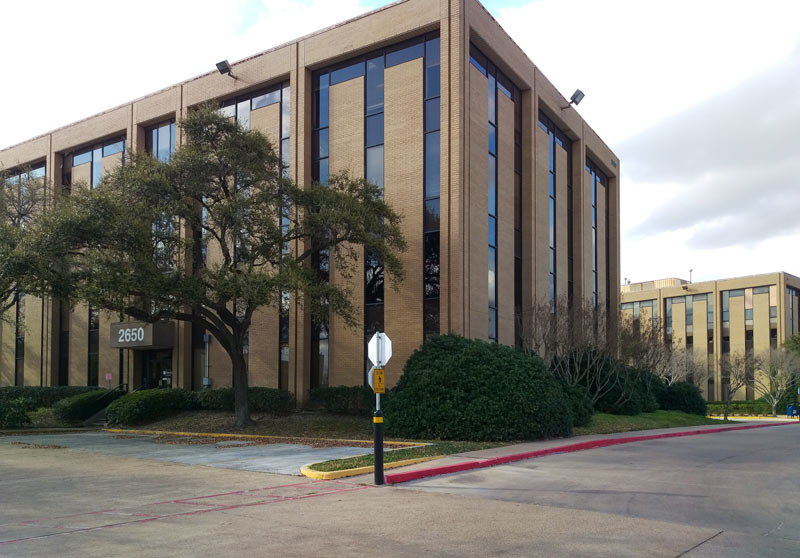
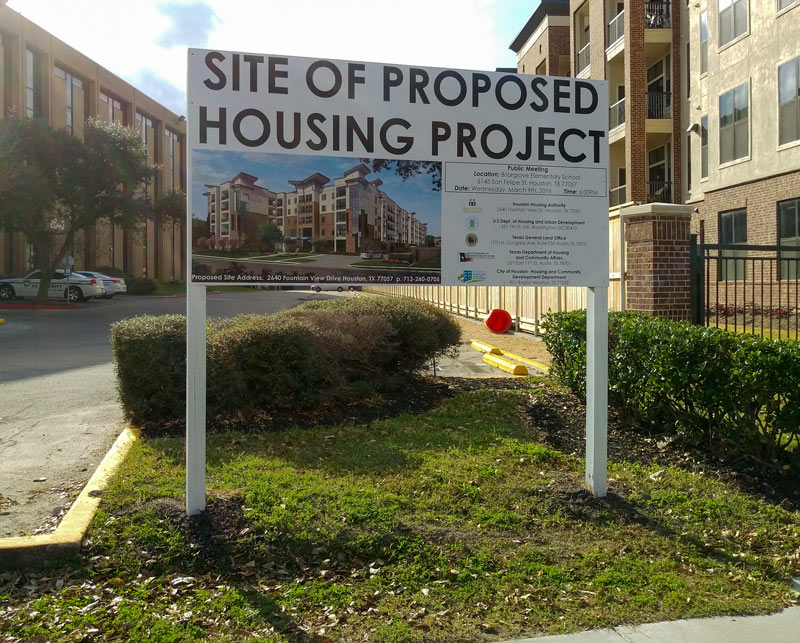 Here are some shots from the scene of the Houston Housing Authority’s office park on Fountain View Dr. north of Westheimer Rd., which the organization is planning to partially demolish and replace with a 233-unit mixed-income apartment complex. The sign shown here went up last month to advertise this week’s public meeting on the proposed construction, which drew standing-room-only crowds to the auditorium of Briargrove Elementary. A group of neighborhood residents is campaigning to stop the project; listed grievances include a lack of transparency surrounding the project, and asserting that school overcrowding wasn’t considered when HHA picked the spot.
Here are some shots from the scene of the Houston Housing Authority’s office park on Fountain View Dr. north of Westheimer Rd., which the organization is planning to partially demolish and replace with a 233-unit mixed-income apartment complex. The sign shown here went up last month to advertise this week’s public meeting on the proposed construction, which drew standing-room-only crowds to the auditorium of Briargrove Elementary. A group of neighborhood residents is campaigning to stop the project; listed grievances include a lack of transparency surrounding the project, and asserting that school overcrowding wasn’t considered when HHA picked the spot.
The property, just north of the vacant H-E-B northwest of the corner with Westheimer, currently holds 2 office buildings sporting gently-bent-rectangular floorplans (that’s 2650 in the foreground, in the photo above, with 2640 behind it). An aerial rendering released by HHA shows 2640 swapped out for the apartment building, with the southern office building still in place below it:
***
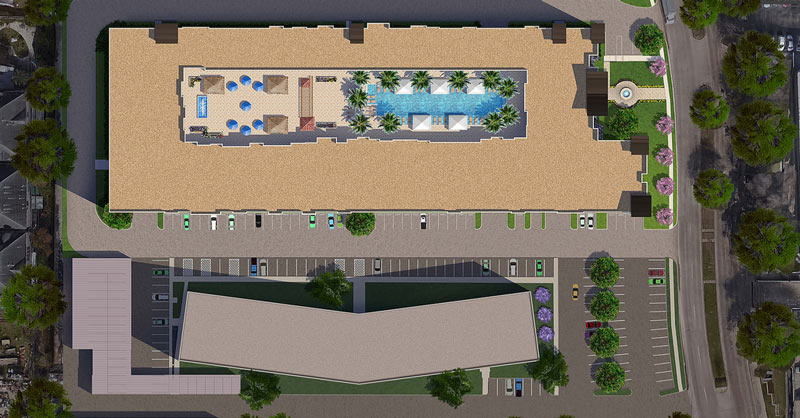
The drawing depicts a central courtyard holding a pool and patio area. Here’s a view of the complex from Fountain View, which shows 4 residential levels and ground-level parking:
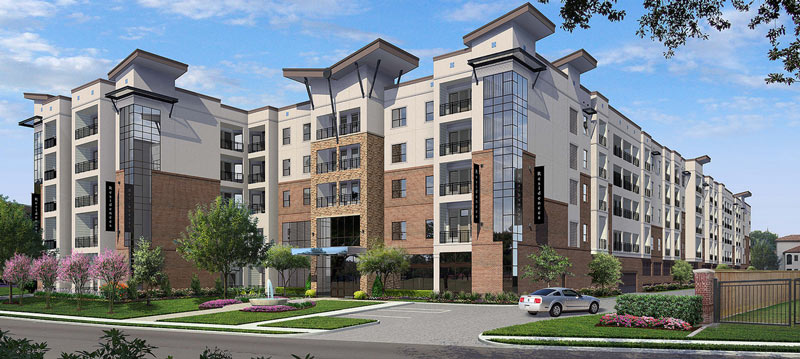
A look at the south elevation:
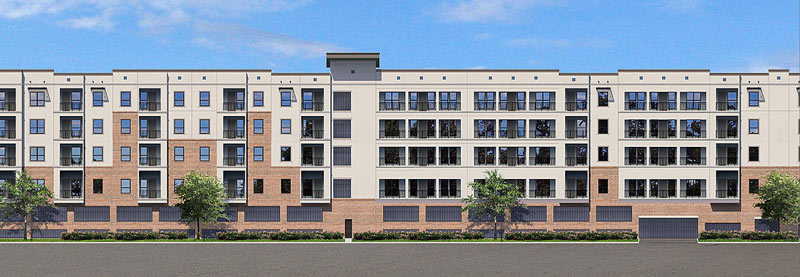
And here’s the back of the building, looking from the east:
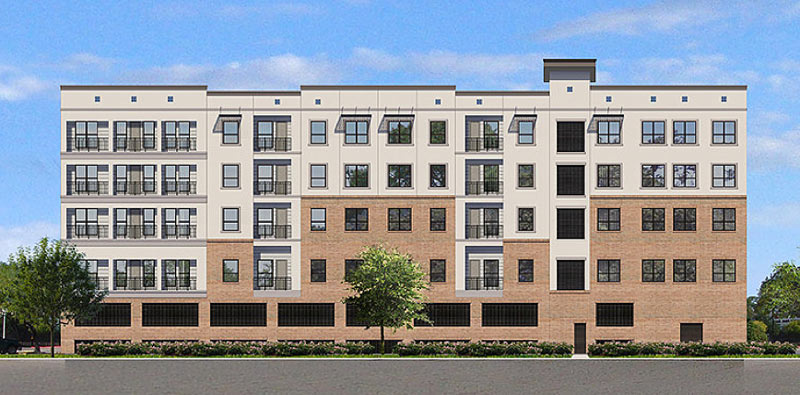
Meanwhile, a reader notes that the site out front of the office blocks seems to be supporting some temporary cell towers, as well as leasing signs:
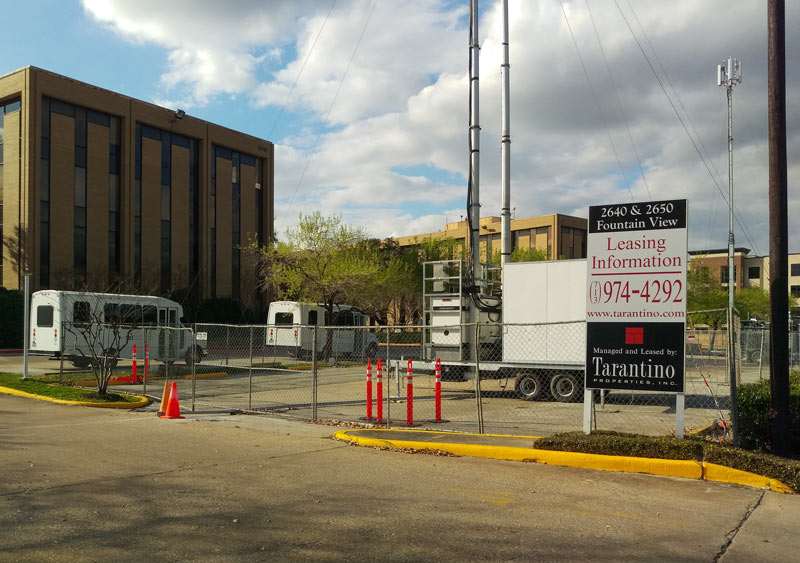
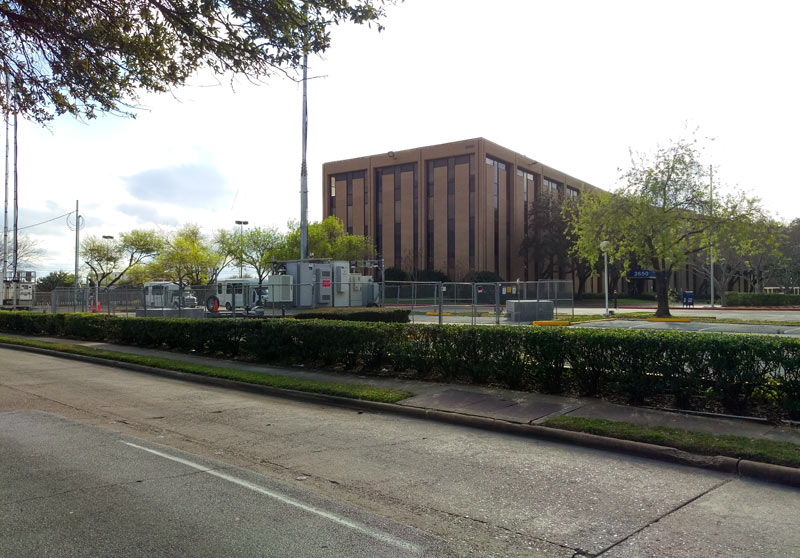
While one fifth of the units would be rented at market rates, HHA says the majority of the complex would be reserved for families making no more than 60 percent of the Houston average, with another 10 percent reserved for families with incomes below 30 percent. If the $53-million project moves forward as currently planned, construction on the apartments could start by the end of the year, and some units could open to residents by late 2018.
Next door to the north are the 2626 Fountain View apartments, across the street from the corporate headquarters of Mexican restaurant Doneraki and the Consulate General of Venezuela.
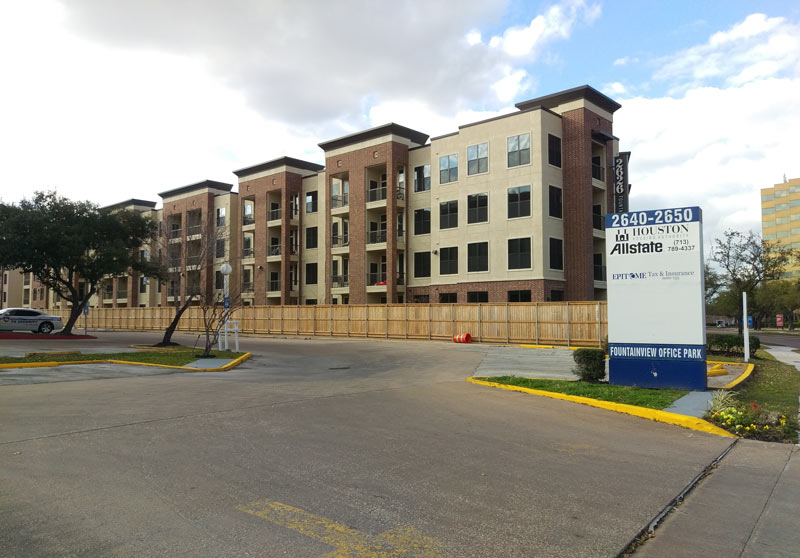
- Housing officials address worries over mixed-income complex [Houston Chronicle]
- Affordable housing proposal puts neighbors on edge [Houston Chronicle]
- 2640 Fountain View Dr. [HHA]
- Mission [Stop Fountainview Project]
Photos: Swamplot inbox


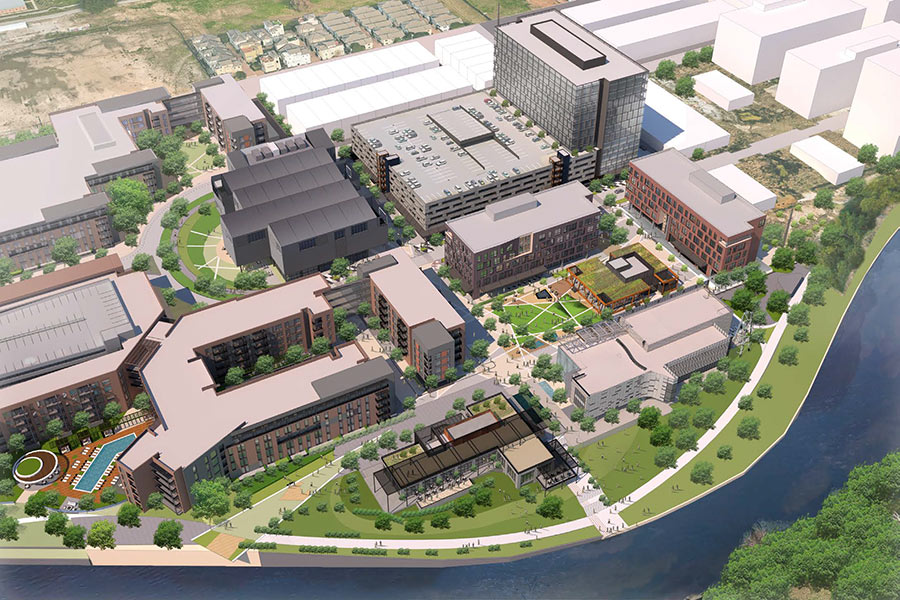

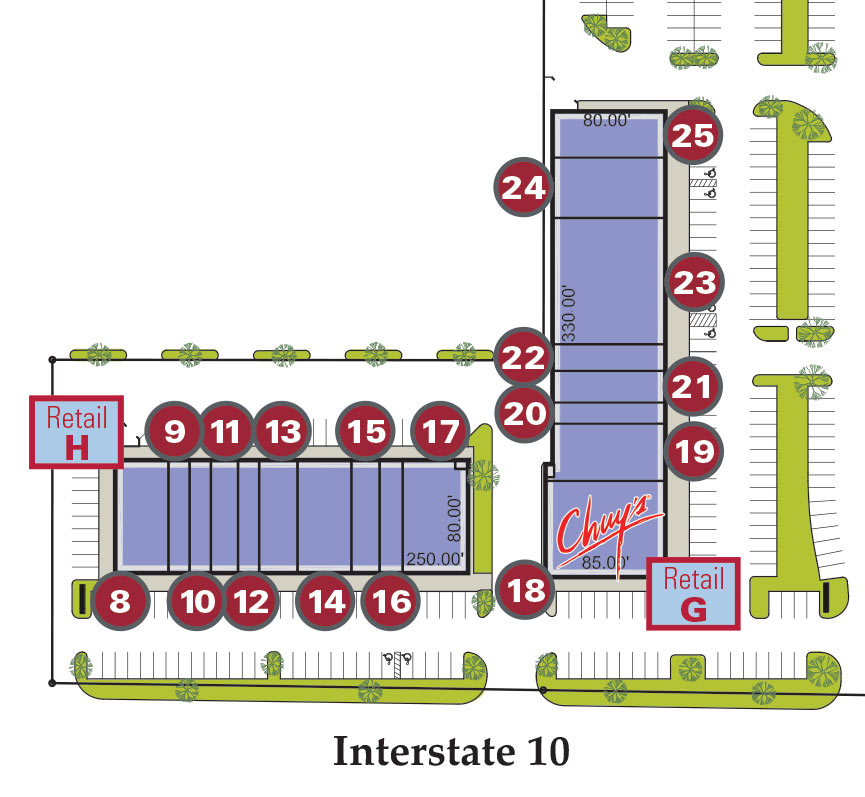
If only car dealerships would apply the same concept of affordability then I might be able to buy an escalade or lambo at the expense of others.
I attended the meeting and was amazed at the rancor on both sides. The high point of the evening was when a young man accused Lance Gilliam of having a conflict of interest, citing that his firm was the broker of record for the sale of the office buildings before HHA bought them. Gilliam holds a high position in the HHA as well, hence the conflict. He said that Waterman Steele did the work pro bono, and that his associate was the broker, but the audience was not placated by that assertion. The 6 Million Dollar Development fee may also have had something to do with the audience’s concern about the whole process. I would say that cockroaches were more popular with the audience than Lance Gilliam would be, at least the roaches have nutritional value. You can pull the Winter 2014 listing flyer from the REDNEWS website still if anyone wants to see it. Another speaker cited that many of the units will be subleased by the tenants, and that many more children will actually live there because of this little known fact, causing even more crowding. HHA won’t be able to police this practice and the thing will basically morph into what everyone is fearing.
Ladies and Gentlemen, this is a disaster. 230k a door smells like a government deal gone wrong. There is plenty of existing affordable housing in the area. The free market is working fine. For that per door price, Why not buy all these folks single family homes in the suburbs? Or maybe just set the money on fire? Central planning never works. The top down directive from HUD, Barry Obama and recent Supreme Court rulings have lead us to this. It was NOT the one thing. it is the dismal tide.
IMHO There are many reasons this part of town is nicer than other parts. People pay top dollar to live in this area, which generally means they are well educated and have an interest in their children’s education, being able to pay top dollar for housing/house means they have money to spend, which means retailers want to be close to them, which means landlords can build nice buildings and charge nice rents and so on. As a general matter, people that live in the area don’t rob the retailers – the retailers rob them. It is this symbiotic relationship that leads to the area being nice. i would offer, as a general rule, Rich people take better care of their property or simply can afford to pay someone to take care of their property. Hence the area looks nice – albeit the vacant HEB looks like garbage.
I think we’re looking at more than one issue here. School over crowding here. property values over there. It’s that fear of what is to come. Getting set to build. Then, whoa, differences, and… Might not even be no tax credit project housing. That’s possible. But you don’t believe it? No.Probably I don’t. Well, it’s a mess, ain’t it, sheriff?If it ain’t, it’ll do till the mess gets here.
Yall lemme know and stay safe. Feel the Bern. Feel it my brother.
Some low-income housing tenants SUBLEASE their units? Oh well, why not. Regular income folks sublease stuff all the time, as long as the terminal lessor is good with it. But if the HHA cannot police this, what else can they not police?
The fact sheet says 2/3 of units will be 1 bedroom or studio apartments. The remaining 1 / 3 will be for 2 bedroom apartments. This complex doesn’t really seem to be geared toward helping low income families. It looks like a money grab by the developers. Why do low income single people need a brand new apartment with prime real estate in-town? Doesn’t make sense. The money could be better used on a different project than a “luxury” apartment complex.
Somebody just needs to file a civil suit with a TRO. Sure it may have no merit at the end but it will take two years to find out. That’ll quickly let the air out of this project.
@Leonard I was also at the meeting, and I think a large part of the concerns are:
1) the abject lack of transparency in the process. The HHA’s assertion that they made the project known publicly is a joke. Every elected official in attendance stated that they had ZERO knowledge of this project until late 2015, FAR after the project plan had been put into place.
2) wasting our tax dollars via the astronomical price per door ($200k+) to develop this project, when similar, private-sector properties range from 100k-115k per door. The money really could be better spent elsewhere – meaning more units at less cost – and helping more families in the process. So it begs the question – is this really about helping low income families, or is this social justice/engineering?
3) Yes, school overcrowding. It is fact that 100+ students were turned away from Briargrove at the start of the 2015-2016 school year. This would add to that problem.
Personally, I thought the idea of making it a low-income senior living facility was a great way to placate both sides….but sometimes ideas like that just make too much sense.
@BoarCoon +1 to your comment! You definitely hit the nail on the head about parents who care about education & who are involved in their children’s schools. To me, that is one of the biggest factors driving the success of students – and as a byproduct, the schools.
Yall remember when Lee HS, was actually a good school (when it was called Robert E. Lee high school). Now it is something like 60% low income, and no one with a choice goes there. That is what is going to happen to Briargrove.
This deal is being pushed from the federal level. It is another redistribution scam by Obama, meant to take from the “rich” and give to the poor.
Oh, and yea I never have been a Lance G fan either.
Still don’t understand who thought it was a good idea to take a piece of property that already had high rises on it, (meaning it was near its highest and best use), and tear those income producing buildings down to make way for a lesser use. It’s bad for the City and County–there will be no property tax taken in, no business taxes generated, and lots more Ciry services and utilities required for the site. The costly infrastructure improvements needed for this are never mentioned- will a new lift station be needed? Where will it go? Will eminent domain be used if HHA decides they don’t want it On their site? Could add millions to the bill. There are lots of layers to this thing as yet unexplored. Culberson needs to kill it if he can.
Commenter, I’ve been a low-income single person before. Affordable housing here would have been walking distance from the job I had at the time and had relatively direct crosstown access to the University of Houston, which I was attending with as much support as I could get at the time. What do you think low-income people should have? Tenements in the least accessible parts of town? It certainly would keep the poor people out of sight.
First of all, this is not a super nice area. Dozens of cheap apartments in every direction, pot holes GALORE, shady people roaming Westheimer 24/7, pan handlers on every corner, not to mention the 3 strip clubs within a $4 uber ride radius.
Second of all, that is it. It’s close to a nice..er… area, but this section of Fountainview is not nice at all. Please, there are beggars at the Starbucks at San Felipe @ voss. Thanks 2nd Baptist? Even though this is classified as Greater Uptown, it’s not.
@Chris – it’s being sold to the public as being housing for families but it absolutely isn’t. The profit margin would shrink without those studios and one bedroom units and would dissapear entirely if there was a third bedroom in every unit. Single people living in the city can find housing they can afford by sharing houses and getting creative just like they’ve always done. This is a sham saying it is for families. It will be a party pad for single people.
@Bocepheus – The statistics for Lee are way worse. 95% of Lee’s students qualify for Free/Reduced lunch.
I applaud this mixed-income project. Everybody needs to live someplace and better to live near work.
And even with subsidies ‘many Galleria workers won’t be able to afford to live there’!
So, chill everyone. You already live behind gates and drive with your windows up.
It’s Lance G. Unlike some other speakers, I am not running for office. I was simply entrusted by Mayor Parker to join with 6 others to share the responsibility, as an unpaid volunteer, to insure HHA meets its obligation to respect both the Houstonians it serves and the taxpayers who provide funds to us.
In regard to transparency, at least two speakers lied when speaking at Wed’s meeting. I tried to hand them e-mails which contradicted their remarks and have already been provided to the press and via TPIA to protagonists but neither wanted to be constrained by facts. Fact: I personally hosted lunch with Dr. Grier in 2011 and afterwards met with HISD Chief Operating Officer Leo Bobadilla in both 5/2012 and again in 4/2014 to discuss how our authority should (1) insure HISD is prepared to educate residents’ children including especially those living in new developments and (2) identify opportunities for HHA to purchase surplus properties from HISD.*
After my 4/2014 meeting with Bobadilla —- prior to HHA purchasing the Fountainview site —- a senior member of authority’s staff met with HISD staff and afterwards provided in writing — yes there’s an e-mail — the size and composition of the proposed development. From the information our authority provided to HISD, projections regarding the number of school age children have been incorporated into their planning for the area. — yes, there’s another e-mail that confirms that, too.
In 4/2014 I also personally began sharing information with Trustee Moore and subsequently CM Pennington and his then chief of staff John Moss. (more e-mails to confirm) Each and every time I met with Moore and Moss, I was candid. Candid means: based on federal policy and agreements in place at the State of Texas, I did not foresee the circumstances under which this development would not be constructed. Neither Moore or Moss chose to share any of this information with their constituents.
In regard to cost, the per unit cost is VERY high; I know that. comparable market rate units of similar design and quality are being designed and built by Houston’s market rate multi-family developers for about $185,000 – 195,000 per unit. although a large part of the difference results from the relatively low density of the development on $60+ PSF land (233 units versus 350-400 units if developed by a market rate developer) and the fee** allowed by HUD rules, our authority continues to work to insure the best value is obtained. (we have respected market rate developers looking over our shoulder and reviewing our numbers. we also have incredibly defined procurement rules which, for example, requires us to accept the lowest big from a qualified contractor).
In regard to my firm —- no good deed goes unpunished or at least criticized— instead of paying one of my firm’s friendly competitors a fee —- probably in the range of $250,000 —- to advise HHA in its evaluation and purchase or this site, one of our firm’s partners provided those services for free. neither my firm, its partners or I have ever received any fees for services from HHA.
Finally, as I have shared with many, our authority fought hard to earn the right to invest this $50 million, about 1/2 of which is from taxpayer funds and the balance from third-party sources (lender and sale of tax credits) in lower-income communities like Sunnyside. we were the only public housing authority in the country that filed an amicus brief in TDHCA v ICP. that case was heard and decided by the U.S. Supreme Court; Justice Kennedy was the “deciding” and fifth vote. we lost. it’s now our authority’s responsibility and legal obligation to provide affordable housing choices throughout our ENTIRE community especially in so-called high opportunity neighborhoods like those that surround Fountainview. (BTW if you’ve never been to a hearing at the US Supreme Court —- do it. it’s an incredible experience; very powerful and very reverent).
All facts. If you’d like copies of the e-mails, let me know.
Lance
* HHA subsequently bought the site of Kennedy Elementary in Independence Heights from HISD
**100% of the fee is retained by our authority, not paid to third-parties, and mostly reinvested as equity in additional development.
How many multifamily developments have gone up in the briargroveschool zone in the past ten years? How many have been protested for putting a strain on Briargrove elementary?
Warehousing low income residents on the wrong side of the tracks in substandard housing is a bad investment all around. Crime goes up, the housing gets trashed by residents who could care less if they are evicted and residents are often in food deserts and far from employment centers, good schools and other amenities. Build a quality development in a good area and you will see significantly less crime from residents, better opportunities for families and lower upkeep and maintenance costs as residents understand that it is a privilege to get to live in a nice building versus the typical subsidized housing.
Thank you Lance for your thorough response. I have a question though, which is why density is being limited by comparison with a market-rate project? If the cost per unit can be brought down by simply increasing the density, then what is the limiting factor?
well, well, well. :::: gets chair and popcorn ::::
Excellent comment, Mr. Gilliam.
.
The more I watch these housing battles; the more I visit disadvantaged areas; and the more I get into books like “Evicted: Poverty and Profit in the American City,” the more I am convinced that there are fundamental problems with housing policy in the US.
.
First, as you have noticed, local housing officials are in a no-win situation. They can do what he Feds tell them to do, and be pilloried by their neighbors. Or they can stand on the side of neighbors, and face terrible punishment. And as if that weren’t bad enough, these fights are expensive: in terms of money but also in terms of time.
.
Second, we’re turning our backs on poor minority neighborhoods. Low income housing gives a handful of workers a chance to move to “high opportunity” neighborhoods. But too little is done to bring opportunity to poor areas, and especially poor minority areas.
.
Finally, people are fighting the wrong enemies. Neighbors are fighting affordable housing developers. Affordable housing developers (and advocates) are fighting neighbors. Meanwhile nobody’s fighting the enemies that need to be fought: slum lords who take advantage of tenants and wreck neighborhoods; corporate execs that choose poor neighborhoods as a location for dirty factories; police departments that rule poor neighborhoods with an iron fist; local governments that have double standards for the rich parts of town versus everyone else….
.
It’s really infuriating.
@ ZAW: Regarding your second point, it is helpful to bear in mind that the HHA’s scope is limited not only by funding and recent SCOTUS decisions, but also by its own mission and charter. And while they’re certainly capable of talking to other government and non-profit entities and trying to cobble together alliances, their territory of responsibility is really quite large; localized successes would likely just have the effect of pricing-out poor people into another part of their jurisdiction (or worse) into a smaller and less capable jurisdiction that is even further from the employment and social services within HHA’s jurisdiction.
You’re right that there are no easy answers, though.
In regard TheNiche’s question about density …. simple answer. we don’t have funds to build more. although if we built “more,” concerns about potential impacts on neighborhood schools would be heightened depending on unit mix and income and/or age focus, the demand for “more” absolutely exists. we anticipate the 233 units currently planned to be fully leased upon completion. our board shares my desire to add more capacity aka more affordable multi-family homes throughout the entire city; we are working diligently to identify more sustainable models than waiting for congress to appropriate funds after a disaster to do that. our peer authorities have, in some cases, found other paths; we’re looking at those too. Lance
Lance, since you seem to be responding to questions in this comment string, I’m wondering: does HHA have to abide by Davis-Bacon in constructing its projects? Seems like that might have a strongly deleterious impact on construction costs.
In re: Local Planner. Yes, our authority has to abide by and respect Davis Bacon requirements. Our federal procurement rules also require us to accept the lowest bid from a qualified contractor notwithstanding whether or not they are a local firm or minority owned firm. Although our authority has worked diligently to insure opportunities for minority owned businesses and to encourage our contractors to employ our residents. That being said, you’re correct in inferring that Davis Bacon requirements affect how our pricing compares to market rate developers.
BTW —- I am pleased to answer questions. my e-mail address is lgilliam@watermansteele.com. many questions are already answered on our authority’s website: http://www.housingforhouston.com where there is a link to the Fountainview development site.
The Feds getting involved just shows how corrupt this deal really is. Picking and choosing which kids get to go to Briargrove is absurd.
I bet Lance G’s kids have never seen the inside of an HISD school.
Lance, thank you for your response. I sort of expected that you’d make one of those two points; you made both.
Having worked in private-sector multifamily development previously and also in various public-sector consulting roles, and based on the figures that you and Swamplot have provided, it does not appear that your density assumptions or construction/improvement costs are unreasonable on their face. However, I am still concerned that under-building the site poses a substantial opportunity cost.
Total HHA Cost: $53 million
(-) 50% Land Costs (Half of 273,542sf @ $60+ PSF, lets say $62.50, is $8,548,188): $44,451,813
(-) Land Cost for Used Portion: $8,548,188
Improvement Cost: $35,903,625 (or $154,093/unit)
Total Cost for Housing Project: $44,451,813 (or $190,780/unit)
Total PRIVATE Cost ($185k-$195k/unit, lets say $190k/unit & 350-400 units, lets say 375 units): $71,250,000
Land Cost (same as HHA + $250k brokerage fee / 2): $17,346,375
Improvement Cost: $53,903,625 ($143,743/unit)
So, to go from HHA’s 74 units/acre on a podium to PRIVATE’s, 119 units/acre also on a podium, the difference is $18 million even divided by 142 units, indicating a marginal construction cost per additional unit over 233 units of $126,761.
But of course, there is no additional land cost for that marginal improvement, so your budget constraint means that you are paying $190,780 per unit for the first 233 units and then foregoing the opportunity to build an additional 142 units at $126,751 each. That is a very substantial opportunity cost!
If my calcs & assumptions are accurate — and it is important that I have apportioned the land costs appropriately, although the point ought to stick no matter what — then I would strongly suggest selling the other half of the property, other assets, or (if possible) borrowing on other assets as collateral in order to make this project larger. How many opportunities is HHA ever likely to have to build apartment units in a “high opportunity” area for $127k per unit!?
Now, I want to be clear that I really respect you coming on here to a mostly hostile audience and making your case, and you’ve made it well in my opinion. Maybe there’s something I’m not considering; its certainly possible, but right now I’m scratching my head.
Spring Branch ISD yes, HISD no. but, it’s fascinating to me how Feds = corrupt. I hadn’t been to Washington DC in about 17 years and it now feels like and may be true that I’ve been there 17 times in the past 6 years. (I think the real number is about 10x — just feels like a lot more). Although funded by Federal dollars and guided by the long strings that accompany those funds, our authority is governed by the Texas Government Code. We have financial statements audited by an independent private firm. (HUD audits us, too) we have a Standard & Poor’s rating — a good one. If you read our meeting minutes you’ll find we use performance standards like occupancy rate, turnover time and resident satisfaction to judge our own performance. We’re not perfect and when we make a mistake we own it, fix it and hopefully don’t repeat it. Whether you agree with the Federal policies that guide us — and check the record because we often don’t either — those rules, regulations, policies and laws have to be respected. And, yes, we respect them.
In re: Niche. great point. one I am forwarding to our folks at the HHA. as I read your comments I was anticipating a different path than: what a great idea to build new units for $127,000 each. more to follow. Lance
$200k+/door ????????? You could buy 1000’s of existing units for 1/4 that price per. Why not just take over all the ‘bad’ properties where the city thinks the owners do a terrible job, and fix them up?
.
Hell, every garden style apt owner in Montrose would sell for ~1/2 that.
Niche’s idea could work from a political standpoint, too, if the additional units were broken out and became seniors housing. Still affordable, and still meeting the HHA’s mission requirements, but not adding any students to Briargrove Elementary. This could be in the same building; just accessed by a different entrance. (Like they do in some buildings in New York).
.
Cody: I was wondering the same thing. For $53 million, the HHA could buy ten apartment complexes for, say, $3 million each; put $2.3 million into each to address all the code violations and deferred maintenance, and of course change out HVAC, windows, appliances, and finishes. Instead of 233 units, they could improve and preserve close to 2000.
.
Why don’t they do it? Mr. Gilliam can correct me if I’m wrong, but near as I can tell, HUD’s policy actually discourages this kind of thing, even if the existing complexes were strategically chosen in areas expected to gentrify soon. HUD says they’re still in low opportunity areas, so it’s a no-go. So we rely on right minded private investors (like Steve Moore, and you, Cody) to do it.
in re: ZAW, you’re right. our authority has actually purchased a couple of existing properties and continue to look at other acquisitions. however, acquiring older units in gentrifying —- term I have become to dislike —- neighborhoods instead of building a new community in a so-called high opportunity neighborhood is problematic. as our board has become frustratingly used to, funds are allocated for specific purposes, development not acquisition, and directed to or, more importantly, away from neighborhoods based on their demographics. our authority is not given the latitude by HUD or, because of a conciliation agreement with HUD and housing advocates, by the State of Texas’ GLO to invest as our board would prefer. more often than assumed, our actions are constrained by rules, regulations, laws and even Supreme Court decisions. that being said, our authority really is looking for more innovative ways to make impacts. “everyone” should also be mindful that we’re only one “tool” in the affordable housing toolbox. there are a lot of entities including the City of Houston’s Department of Housing and Community Development and non-profits like Avenue CDC and New Hope Housing who do amazing work in different communities and formats ranging from single-family homes to single-resident occupancy housing. BUT … conversations like these are good one. the idea of adding senior housing at a lower incremental cost is one we should or arguably should have considered. Lance
Lance,
I was at the meeting and though I appreciate you taking the time to speak then and responding to comments now, I am still opposed to this project. I am opposed to the project partially due to the high price/waste of government funds, but mainly due to the strain it puts on an already overcrowded school. Since you say that you were meeting with HISD on this project for several years, did they ever bring up that the school is currently full? And that the overflow school Mark White is also going to be full? Even if they did not bring this up then, now that HHA knows this now, I don’t see how you can proceed with the project. If kids that are zoned to Briargrove are currently being sent to schools as far as Memorial Park or Shepherd and 14th Street (like the HISD representatives said at the meeting), then this location makes no sense for this project. If the goal of this location is to develop low-income housing in a nicer area with access to better schools, HHA is going to fail to achieve this goal without a school with available spots in this area. The maps distributed at the meeting showed that there were 9 schools in the Houston area that were located in areas meeting HHA’s criteria for a development AND being utilized at less than 85% capacity. Briargrove was not one of those schools! Please find another property for this housing development in a suitable area with available capacity at the elementary school. The results there would be much better for HHA and their residents and for HISD and Briargrove Elementary.
Thanks,
Chris
In re: Chris H as you may surmise from my engagement here, I didn’t like the format of the meeting. for a number of reasons we effectively had to use the present and listen —- no response — format. it left a lot of folks frustrated because they wanted answers to their questions “right then and right now.” it also almost perversely allowed a lot of statements to be made by protagonists that “weren’t true” aka “were lies.”
Notwithstanding what you heard or what was said, I PERSONALLY began an engagement with Dr. Grier and his chief operating officer at HISD in 2011 that continued into 2012 and culminated in 2014 with our senior staff providing HISD with specific information about the Fountainview and other proposed developments IN WRITING in 5/2014. At no time until Harvin and I visited in late 2014, after our authority had purchased the site, were we told that the 42 (HHA estimate) or 60 now 70 (HISD estimate) elementary school age children would “displace” existing students and exacerbate crowding. Instead, our authority was told that HISD had incorporated their (not our) estimates of children into the planning for area schools including the Briargrove and the new Mark White Elementary. I confess to now understanding much more about HISD lingo including what “capacity” and “capped” means but am still struggling how 42 (or 60-70) children out of a total of about 3,000 can’t be educated in one of four good schools within a mile of the proposed development.
Last note: as I shared with a number of folks after the formal meeting’s conclusion, if you want to have a conversation about whether taxpayer funds should be used to incentive aka subsidize affordable housing, that’s a topic for Congressman Culberson, Senator Cruz and Senator Cornyn. If you want to have a conversation about whether affordable housing choices should be provided throughout our entire community and especially in so-called high opportunity neighborhoods, good luck: that one was settled by the U.S. Supreme Court, over our authority’s objections, last summer. So, the challenge now is: how to respect the funds our authority is given for a specific purpose? Before proceeding, my fellow commissioners and I will insure the community’s questions are answered and further that the budget has been tested against the same metrics used by Houston’s highly respected multi-family development community.
@ LanceG: I would suspect that HISD has databases that pair enrollment to street addresses that can easily be defined with tax rolls as being single-family, market-rate multifamily, subsidized multifamily, or other classifications of residential property, but that they do not have the data to pair students to individual multifamily units according to the number of bedrooms therein. They may not even have the unit mix for each complex because that is not in the tax roll (although such data is available from private sources at a reasonable cost if you or they are interested), and if they don’t have that then they aren’t even able to run a good regression-based study. As such, their model may assume that every multifamily unit mix is average. Yours certainly isn’t! With two-thirds of your units being studios or one-bedroom units, I think that HHA’s estimates are probably more reasonable than theirs.
Furthermore, your organization probably DOES have the fine level of detail (which hopefully is digitized) on school-age students contained per subsidized multifamily unit by type. You may be able to throw in other factors to the regression (such as marital status, income, creditworthiness, and rent paid) to check for whether those factors correlate to the number of bedrooms and expected numbers of children. HISD certainly cannot do this on their own.
You might try scheduling a call with the HISD demographer (Justin Silhavy). He’ll be able to go over their terminology and predictive modeling methodologies in finer detail. It’d be educational for you, but also if you can help them then perhaps this is an issue that can be mitigated.
(I should really charge y’all a fee, BTW.)
In re TheNiche … I will make you a deal. I’ll buy you breakfast or lunch; more than I get. reason is: you’re not first but you’re still right —- very right.
Our authority does have all of the data you referenced —- for about 3,000 units of tax credit housing. It’s what we used in projecting 42 elementary school age children instead of the 60 (maybe even 70???? — a number we first heard at our public meeting after Harvin Moore was speaking, leaned down to Justin’s boss, Mark Smith, and then said, “60 …. maybe even 70” children. 10 doesn’t sound like a lot but it’s a 16.7% variance apparently calculated in seconds in front of a not so friendly crowd).
That being said, ironically Justin is who our senior staff member (Brian Gage) met with in 5/2014 and subsequently (same day) e-mailed (BEFORE we bought the site) with data regarding our projected development which at the time we thought would be “200-250 units with a 40/40/20 mix” (one bedroom, two bedroom, three bedroom). the subsequent real mix is 233 67/33 with fewer bedrooms. We have always assumed HISD used the 250 40/40/20 for their projections which is why they projected 60 elementary school age children; we have too much respect for Justin to think we got it right and we didn’t.
BTW —- one other inconvenient truth, inconvenient for Moore —- about a month ago we began passing all of our published statements about HISD and enrollment by either Mark Smith or Justin Silhavy; that is, we didn’t release any information or make any statement before they agree that information was correct (in writing).
Lance
I think they should consider ..placing this property..as at least half senior citizens….62 snd older…..I think.the redidentd..in the brier grove …would be more pleased.with…
I live in a senior apt …and its quite…not the ..free.loaders..than want to live with ..all the ladies on welfare…and the parents that end up taking care of their children. ..then you have the loll the relatives. .that come in and go…its like a hotel..for their. .friends etc…..section 8..needs to socially…..people….snd uphold …strong…regulations. ….every property
..that allows section.8 vouchers. ..needs security…and curfews. …and strict. ..rules..about..checking …suspected. ..residents. ..that want to party…snd bring in all
Their family. ..their children…snd their children..to live…
.its not a free live in motel..
Just because you ate on a voucher. ….
Sheila Jackson. .snd intelligent. …can over see..snd implement
Need social behavior’s. …just ask her..she will extend her imput
Senior property..
At least half…could help
Redident s in briargrove…community
Feel ..less concerns. ….if you visit senior apt property’s. .on section 8…..you will see a big difference. ….also security…
And curfews. …and implement ING .strict….social behavior’s…
Its important. ..to teach…people ..a better way to live..to think..
Regarding ..
Work ethics…and friends and family d..that sent to …freeload. ….stop.the cycle. …
Having a new child ..every year or so
.will not entitle….a free home…..
Teach and offer..grants. To go to school..and learn…how to provide….
Who are the developers behind this project who will profit from it being built? I never see the names of the people and/or companies behind these projects.